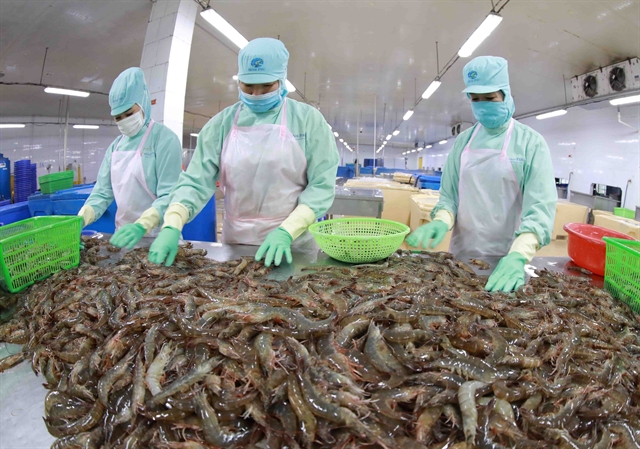 Economy
Economy

To further increase the value of shrimp and to have sustainable shrimp industry development, localities, especially Mekong Delta provinces, need to pay attention to developing high-quality seed sources to have proactive production, reduce production cost and limit diseases.

|
| Việt Nam targets shrimp export turnover of US$4 - 4.3 billion this year. — VNA/VNS Photo Vũ Sinh |
HÀ NỘI — The Việt Nam Association of Seafood Exporters and Producers (VASEP) believes that Việt Nam will have an increase of about 10-15 per cent in shrimp exports this year due to recovery in shrimp consumption of some markets.
In addition, the demand for protein from aquatic products is increasing. Therefore, in the future, seafood production will have more chances to develop, especially shrimp.
Vietnam targets shrimp export turnover of US$4 - 4.3 billion this year.
Regarding export markets, the US and China will continue to be the two largest markets for Vietnamese shrimp exports in 2024, accounting for about 40-45 per cent of the shrimp industry's export value.
To overcome transportation cost hikes due to tensions in the Red Sea, some shrimp exporters have promoted exports to nearby markets, such as China and Japan.
For example, Sao Ta Food Joint Stock Company will pursue the goal of exploring the large market neighbouring Vietnam, haiquanonline.com.vn reported.
Especially, the company will continue to strengthen the development of the Japanese market, maintain existing markets, and focus on understanding and, step by step, penetrating the Chinese market.
At the same time, it will promote the production of deeply processed and value-added products.
VASEP said that Sao Ta Foods is now the largest Vietnamese enterprise exporting shrimp to Japan, ranked 5th to the US market and 9th to South Korea. Focusing on taking advantage of the strength of deep processing and high product quality has helped Sao Ta Foods win many large orders from Japanese partners.
According to Lê Hằng, businesses may have to change export markets and export products, and turn challenges into opportunities.
For example, China will likely attract more businesses to export shrimp from Việt Nam this year, because of its close geographical location, low transportation costs and easier control.
Moreover, China will certainly experience a reduction in supply from Ecuador due to both security instability in this South American country and difficulties in shipping and increased costs.
Therefore, China will have to increase supply from Việt Nam and other Asian countries.
Along with that, businesses will also tend to convert some export products in the context of war, conflict and inflation, the demand for canned, bagged and dried goods, including seafood, with the characteristics of easy preservation, long expiry and reasonable prices, will increase this year.
In addition, the growth of small markets is also a driving force for Việt Nam's shrimp exports to increase this year.
Analysts at FPT Securities (FPTS) now believe that the positive recovery of domestic shrimp supply from the second half of 2024 will not create significant pressure on raw shrimp prices for shrimp processing enterprises. It is forecast that the average price of raw shrimp this year will increase by 5 per cent compared to 2023.
Meanwhile, based on the market outlook, FPTS forecasts that the average export price of Vietnamese shrimp to the US, EU and Japan this year will reach $11.4 per kilo, an increase of 7 per cent compared to 2023.
For the US, Việt Nam's largest shrimp consumption market accounting for nearly 20 per cent of the total export value, FPTS forecasts that demand will begin to recover from the first quarter of this year because frozen shrimp inventories decreased significantly from the fourth quarter of 2023 thanks to year-end holiday stimulus programmes of retailers.
At the same time, US consumers' spending power is expected to improve as food inflation declines and real incomes continue to rise.
For the EU and Japanese markets, FPTS believes that demand will recover one quarter after the US market, due to greater inventory in the EU market and the low likelihood of improved Japanese Yen/US dollar exchange rate this year.
In 2023, Vietnamese shrimp exporters had an advantage in the processed shrimp segment, but Japan's Yen devaluation against US dollar and high inflation caused demand for shrimp in Japan decline.
However, Japan is still considered a potential market for deeply processed seafood products with high added value, which is an advantage of Việt Nam's shrimp industry.
In 2024, climate change is still a problem that needs to be resolved, and adapting shrimp production to climate change will be an urgent solution for the future. Investment costs continue to increase faster than in other countries. Vietnam will continue to have difficulty in price competition with Ecuador and India.
According to Deputy Minister of Agriculture and Rural Development Phùng Đức Tiến, to further increase the value of shrimp and to have sustainable shrimp industry development, localities, especially the Mekong Delta provinces, need to pay attention to developing high-quality seed sources to have proactive production, reduce production cost and limit diseases.
At the same time, investment is also needed to perfect the infrastructure system for the development of farming areas and logistics, towards green production, low emissions and the application of digital technology in aquaculture. — VNS




